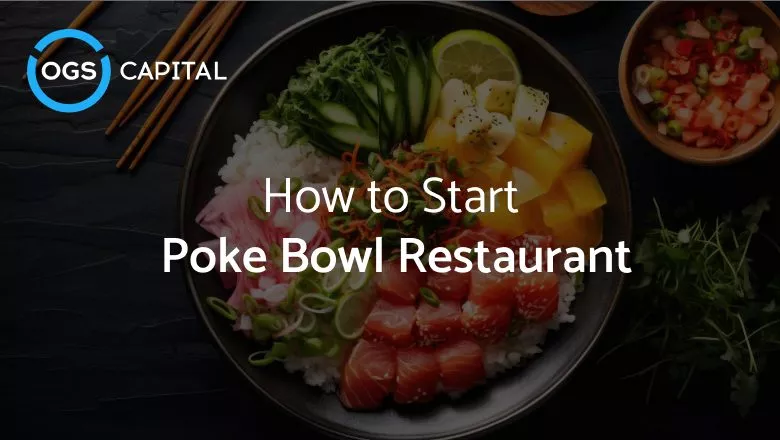Table of Content
Poke bowls have exploded in popularity over the last few years. According to a report, the global market was worth $4.46 billion in 2022 and is forecast to grow at an 18.55% CAGR through 2028, potentially reaching $12.38 billion. With consumers desiring fresh, customizable choices, this business presents a profitable prospect.
What is a pork restaurant or poke bar? A poke restaurant typically specializes in serving poke bowls, offering a variety of fresh ingredients and flavorful combinations. Customers can customize their poke bowls by choosing from various toppings, bases, and sauces at the poke bar.
What’s in the poke bowl food? The contents of a poke bowl include raw seafood like tuna or salmon marinated in soy sauce, sesame oil, seaweed, and spices. Additional ingredients often added are white or brown rice, mixed greens, edamame, avocado, cucumber, carrots, and many sauces.
Origin of poke bowl – The origin of poke bowl traces back to Hawaiian cuisine, where local fishermen would season the leftover cuts of their catch with salt, seaweed, and inamona (roasted kukui nut), then serve it over rice.
This article will guide you through the process of starting a poke bowl business. By following our restaurant business plan sample, you will learn how to start a poke restaurant in no time.
Conduct a Market Research
Market research is gathering and analyzing information about your potential customers, competitors, and industry. To conduct a market research for your business, follow these steps:
Step 1: Identify your target customers and ideal location using our feasibility study for restaurant.
Step 2: Analyze competition.
Step 3: Survey potential customers.
Step 4: Evaluate market trends.
Step 5: Research costs and regulations.
Step 6: Define your brand.
Step 7: Estimate demand and potential sales.
Step 8: Analyze the data and draw conclusions
Business Model
A business model is the way you create, deliver, and capture value for your customers. It defines your value proposition, revenue streams, cost structure, customer segments, channels, customer relationships, key resources, activities, and partnerships.
You can choose from the following models for your poke bowl franchise:
- Mobile truck
- Restaurant
- Delivery service
- Franchise
- Catering
- Subscription
- Kiosk
- Vending machine
- Bar
- DIY kit
- Pop-up shop
Develop a Poke Bowl Business Plan
A business plan is a professional document that describes your idea, goals, strategies, and actions. It helps you communicate your vision, secure funding, and guide your operations. To develop a poke bowl plan, use a template like this food truck start-up business plan or hire a professional plan writer like OGSCapital. Reviewing an E2 visa business plan example can also provide a structured approach for those aiming to use their business for visa applications.
Your plan should include the following sections:
- Executive summary
- Company description
- Market analysis
- Competitive analysis
- Marketing plan
- Operations plan
- Management team
- Financial plan
- Appendix
Tips for Developing a Plan
- Use a template to help save you time and effort. For example, a food delivery service business plan.
- Be realistic and avoid making unrealistic or exaggerated claims or assumptions.
- Be specific and avoid vague or general statements or terms.
- Be concise and avoid unnecessary or redundant information or jargon.
- Be professional by proofreading and editing your plan regularly.
Marketing Plan
A marketing plan outlines your marketing strategies and tactics to achieve your goals. It helps you identify your target market, communicate value propositions, and differentiate franchises from competitors.
Here are the main components to create a marketing plan:
Market Segmentation
Market segmentation is dividing your target market into smaller groups based on common characteristics, needs, or preferences. It helps you tailor your marketing efforts to each segment and increase customer satisfaction and loyalty.
Here are some ways to segment your market for your restaurant:
- Demographic segmentation
- Geographic segmentation
- Psychographic segmentation
- Behavioral segmentation
Promotional Strategies
Promotional strategies are the methods and techniques you use to communicate your product and brand to your target market. They help raise awareness, generate interest, and persuade customers to buy your poke bowls.
Here are some examples of promotional strategies for your poke restaurant:
- Social media marketing
- Influencer marketing
- Email marketing
- SEO marketing
- Content marketing
- PR outreach
- Local events
- Loyalty program
- Partnerships
- Flyers
- Billboard/outdoor ads
- Radio ads
- Grand opening event
You can also combine these strategies to create a more effective and integrated marketing campaign. Consulting with a pitch deck agency can further enhance your promotional strategies by crafting compelling presentations for potential investors.
Financial Projections
Financial projections are the estimates of your future financial performance based on your assumptions and calculations. They help you plan your budget, monitor your cash flow, and evaluate your profitability and growth potential.
Here are the main components to create financial projections for your poke bowl restaurant:
Revenue Assumptions
Revenue assumptions are the factors that affect your sales and income. Make realistic and reasonable assumptions based on your market research, franchise model, and marketing plan.
Some examples of revenue assumptions for your poke franchise include:
- Average ticket of $12
- Monthly sales forecast of a poke bowl business is at $15K in Year 1
- 65% gross margins
- $3K monthly from catering & delivery
- 10% sales increases for return customers, 5% for new annually
- 15% seasonal spikes in summer, 10% dips in winter
- 25% one-time revenue boosts from local events quarterly
- 20% revenue from online orders & loyalty program by Year 2
- 2% annual price increases
Projecting Expenses
Projecting expenses are the estimates of your future costs and expenditures based on your assumptions and calculations. They help you manage your resources, control spending, and improve efficiency and profitability.
The main potential expenses for your poke in bowl franchise include:
- Ingredients
- Packaging materials
- Rent
- Utilities
- Equipment
- Marketing
- Insurance
- Permits and licenses
- Staff wages and benefits
- Professional services
- Repairs and maintenance
- Delivery fees
- Training and onboarding
- Office supplies
Launch Your Poke Bowl Business Successfully with OGSCapital
At OGSCapital, we have the experience and expertise to help you start a successful poke bowl franchise. We are a team of professional plan writers and franchise business plan consultants who have helped clients worldwide raise funding to meet their requirements. Here are some reasons why you should choose OGSCapital for your poke bowl plan:
- We offer customized and high-quality plans
- We have extensive knowledge and insights into various industries
- We can help you access the resources and opportunities to launch and grow your franchise
- We provide ongoing support and guidance
Contact us today, and let us help you turn your profitable poke bowl vision into reality.
Frequently Asked Question
Why is the poke bowl business so profitable?
The poke bowl business is profitable because it offers a healthy, customizable, and convenient dining option that appeals to many customers. According to industry experts, the average poke bowl profit margin in the US is around 15-20%.
Is it expensive to start your own poke bowl restaurant?
Yes, opening a poke restaurant is expensive. The typical startup costs for a poke bowl restaurant in the US range from $100,000 to $465,000. However, you can opt for a lower-cost alternative like a poke bowl franchise costing a few thousand dollars to start.
OGSCapital’s team has assisted thousands of entrepreneurs with top-rated document, consultancy and analysis. They’ve helped thousands of SME owners secure more than $1.5 billion in funding, and they can do the same for you.













